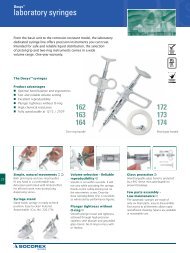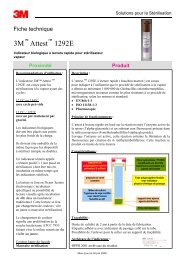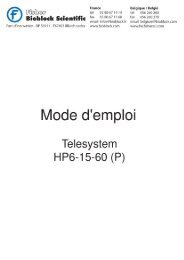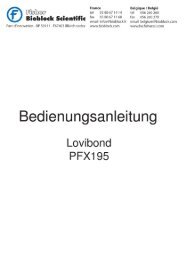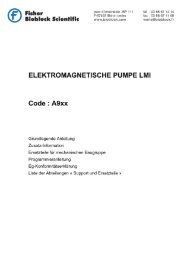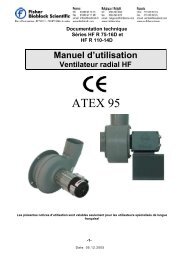OPERATING MANUAL - Bad Request
OPERATING MANUAL - Bad Request
OPERATING MANUAL - Bad Request
Create successful ePaper yourself
Turn your PDF publications into a flip-book with our unique Google optimized e-Paper software.
Operation and control<br />
5. Operation and control<br />
5.1 Operating personnel<br />
The incubator may only be operated by persons who are of legal age and have received instructions<br />
for the incubator. Personnel who are to be trained, instructed or who are undergoing<br />
general training may only be active on the incubator under the continuous supervision of<br />
an experienced person.<br />
5.2 Opening the door<br />
► To open the door, turn handle to the right ( Fig. 14 ).<br />
► To close, turn door handle to the left.<br />
When the door is opened, the CO 2 supply is automatically<br />
interrupted. If the heated outer door is left open for<br />
any length of time, condensation may form on the glass<br />
door.<br />
5.3 Loading the incubator<br />
Warning!<br />
When loading the chamber with an<br />
unsuitable load, poisonous or explosive<br />
vapours or gases may be produced. This<br />
could cause the chamber to explode, and people could be badly injured<br />
or poisoned. The chamber may only be loaded with materials/<br />
test objects which do not form any toxic or explosive vapours when<br />
heated up, and which cannot ignite. If there is any doubt as to the<br />
composition of materials, they must not be loaded into the incubator.<br />
Caution:<br />
Check the chamber load for chemical compatibility with the materials of the incubator<br />
(see page 13 ), since considerable damage could otherwise occur to the chamber load,<br />
the appliance or the surroundings.<br />
The incubators are not explosion-proof (they do not comply with workplace health & safety<br />
regulation VBG 24) and are therefore not suitable for drying, vaporising and branding paints<br />
or similar materials, the solvents of which could form an explosive mixture when combined<br />
with air. Potentially explosive gas-air mixtures must not be produced, either in the interior of<br />
the chamber or in the direct vicinity of the appliance.<br />
Heavy dust production or aggressive vapours in the chamber or in the vicinity of the appliance<br />
could lead to sedimentation in the chamber interior and as a consequence, could result<br />
in short circuits or damage to electrical parts. For this reason, sufficient measures should be<br />
taken to prevent large clouds of dust or aggressive vapours from developing.<br />
The chamber must not be loaded too tightly, so that proper air circulation in the working<br />
chamber is guaranteed. Do not place any of the chamber load on the floor, touching the side<br />
walls or right below the ceiling (heating ribs) of the working chamber. To guarantee an optimal<br />
air circulation, push in the sliding shelves so that the gaps between the door, sliding shelf<br />
and rear wall of the chamber are roughly the same size.<br />
26<br />
close<br />
open<br />
Fig. 14 Opening and<br />
closing the door





